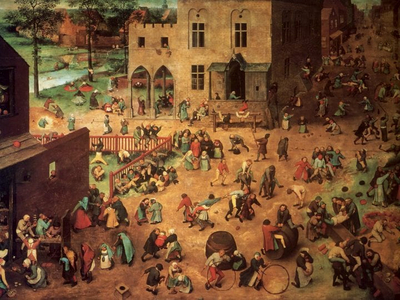Picturing more than two hundred children playing over eighty different games, Children’s Games (1560) is one of Pieter Bruegel the Elder’s most intriguing and least understood paintings.
Encountering Pieter Bruegel the Elder’s Children’s Games for the first time is an experience that is both bewildering and enchanting. The painting’s large scale and unusual, encyclopedic composition render it instantly striking. Stretching to a distant horizon, the ocher ground of Children’s Games is studded with over two hundred children playing around eighty different games. The panel is carefully organized. A wide street sweeps from the lower left corner of the painting, encompasses the players in the central square, and extends to a distant vanishing point in the upper right. The dramatic recession of this diagonal lends the painting an asymmetric thrust, which is intersected by a second diagonal running from the beam on the ground in the lower right of the panel to the verdant countryside in the upper left. Despite these compositional structures there is no sense of narrative order to Bruegel’s collection. The game motifs are all of a similar size and events at the center of the picture appear no more charged with importance than those at its edges. This encyclopedic compositional technique is at odds with the painting’s lifelike motifs: the former encouraging the eye to move continuously over the shifting surface of the panel, and the latter prompting it to pause at each cluster of children and study the drama unfolding.
The challenge that Children’s Games presents to modern scholars operates on many levels, from the fundamental task of identifying the individual games depicted to the wider questions of the meaning behind such a panorama. The subject matter of Children’s Games is unprecedented; its only precursors being the tiny images of children playing seasonal games found in the margins of a number of Ghent-Bruges manuscripts. Circumstances surrounding the commissioning and evolution of the painting are unknown; no documents or preparatory sketches have come to light and the first extant reference to Children’s Games dates from the very end of the sixteenth century. Lacking any of the traditional aides to interpretation, scholars have adopted a variety of approaches to the painting in the centuries following its creation. The labelling and classifying of the games has been enthusiastically undertaken by folklorists, ethnographers, and historians of childhood, for whom Children’s Games represents an indispensable source in reconstructing the specifics of early modern game playing. A second approach to the panel has been the thematic interpretations, in which scholars have attempted to situate Children’s Games within series or allegories traditional to art history, examples being the Seasons or the Ages of Man. These attempts have been largely unsuccessful; the painting contains games which were played throughout the year and therefore resists categorization as a representation of a particular season, and no other works by Bruegel survive to support the notion that Children’s Games belonged to a series depicting the Ages of Man. Iconological readings represent a third type of approach. Here scholars seeking to “unlock” the meaning in Bruegel’s games have been drawn to comparable motifs in seventeenth-century Dutch emblems. Combining depictions of games and toys with mottos and texts that moralize about the behavior of young and old alike, Dutch emblem books appear to offer a key to understanding the deeper meaning behind images of play. Individual games found in emblem books such as Jacob Cats’s Silenus Alcibiabes (1618) and Pieter Roemer Visscher’s Sinnepoppen (1614) have been matched with comparable motifs in Children’s Games, with damning results: the boy blowing a bubble in the left foreground has been read as a vanitas symbol of the transience of life, while the games with hoops in the right foreground have been seen as representative of the futility of life’s endeavor. These moralizing iconological readings have now become dominant in the historiography of Children’s Games, despite the obvious methodological flaw in using seventeenth-century emblems to decode a sixteenth-century painting.
Excerpt from Amy Orrock's wonderful article from: https://jhna.org/articles/homo-ludens-pieter-bruegels-childrens-games-humanist-educators/
